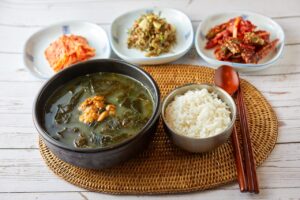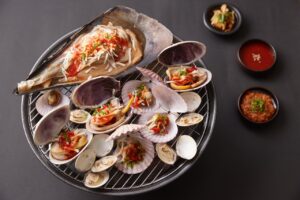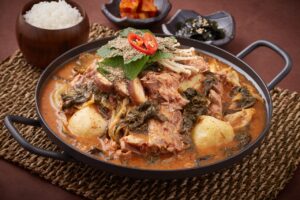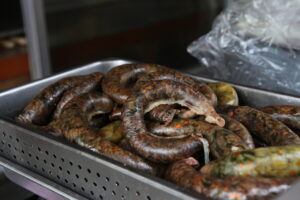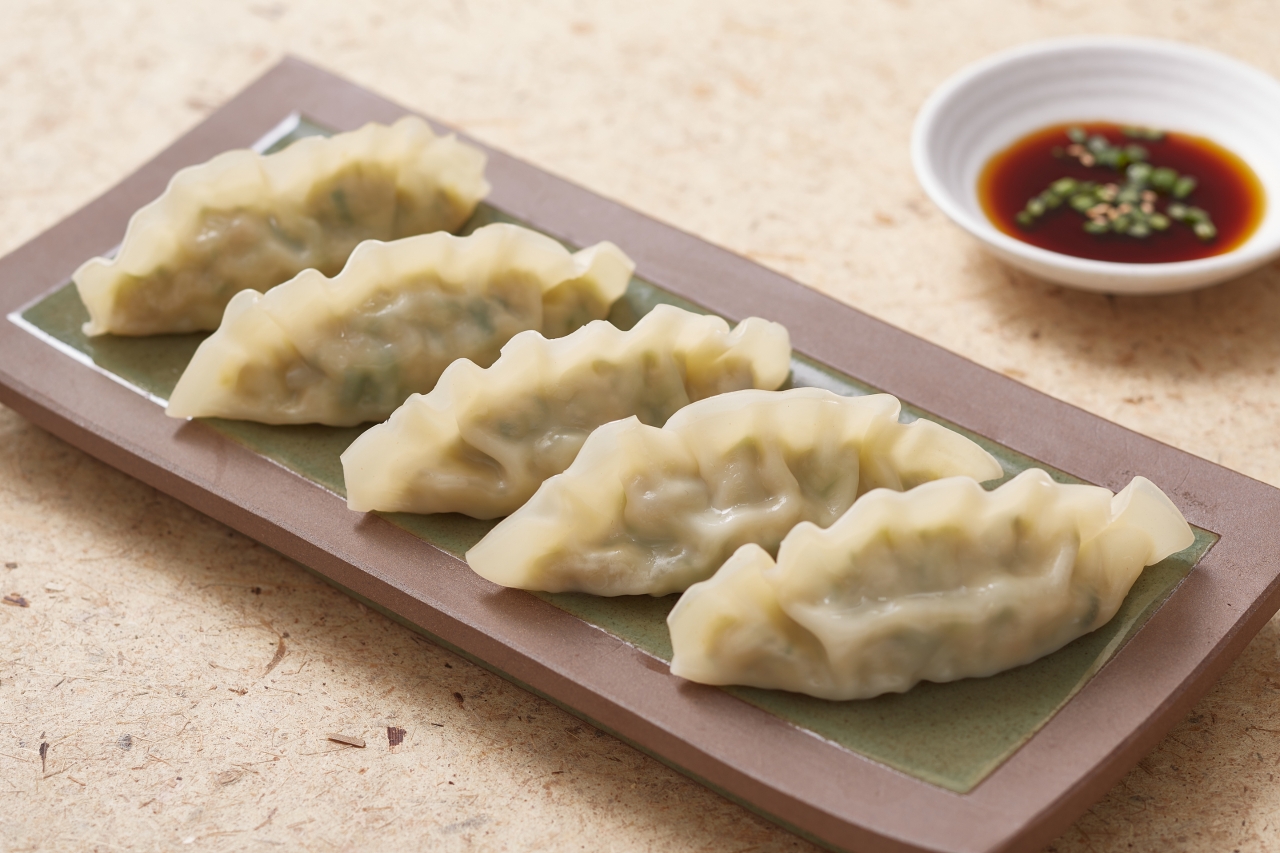
Mandu ⓒ한국관광공사 사진갤러리-디그램
Mandu Popular Korean Dish
Mandu is a popular Korean dish that consists of dumplings typically filled with various ingredients like meat, vegetables, tofu, or kimchi. It has a long and fascinating history dating back centuries. Here’s a brief overview of the history of Mandu:
Ancient Origins: Dumplings in various forms have been part of Korean cuisine for centuries. It’s believed that the concept of Mandu was introduced to Korea from China via the Silk Road, along with various culinary and cultural exchanges.
Goguryeo Dynasty (37 BC – 668 AD): It is thought to have gained popularity during the Goguryeo Dynasty. In ancient times, these dumplings were primarily made with meat, and they served as a convenient and portable food for travelers and soldiers.
Goryeo Dynasty (918–1392): During the Goryeo Dynasty, It started to evolve. It began to include more diverse fillings, such as vegetables and different types of meat, and was enjoyed by the royal court and common people alike.
Chosun Dynasty (1392–1910): This continued to be a staple food during the Chosun Dynasty. It was often consumed in royal palaces and was prepared in various forms, including steamed, fried, or boiled. The Chosun Dynasty era also saw the development of different regional variations of Mandu.
Japanese Colonial Period (1910–1945): The one tradition continued during the Japanese colonial period, although it faced some suppression of Korean culture and cuisine. Nevertheless, the love for Mandu endured among Koreans.
Post-Korean War Era and Modern Times: After the Korean War, it became an integral part of Korean street food culture. Street vendors began selling them in various forms, including fried, steamed, and boiled, making it accessible and affordable to the masses.
Contemporary Mandu: Today, it remains a beloved and versatile dish in Korean cuisine. It is enjoyed in countless variations, from kimchi Mandu to vegetarian options. It is not only a popular street food but also a cherished comfort food often made at home.
Global Popularity: Korean cuisine, including this, has gained international recognition and popularity. Many people around the world have developed a taste for Korean dishes, and Mandu has become a favorite in Korean restaurants worldwide.
Mandu’s long history and adaptability have allowed it to evolve into a diverse and delicious dish loved by people of all ages. It continues to be an essential part of Korean culinary traditions and a symbol of the country’s rich gastronomic heritage.
Zhuge Liang’s Dumpling
The claim that dumplings were birthed as Zhuge Liang’s base is a popular legend in Chinese folklore. Zhuge Liang, often referred to as Zhuge Kongming, was a renowned statesman, military strategist, and scholar during the Three Kingdoms period of Chinese history. He served as the chief strategist for the Shu Han state led by Liu Bei. While this legend is not based on historical records, it has become a part of Chinese culture and the folklore surrounding Zhuge Liang. Here’s the legend:
The Legend of Zhuge Liang and Dumplings:
On the way back from the conquest of South Korea, Zhuge Liang was tied up by severe waves and winds on the river. People say that there is a god called Hwangshin in the old man, and the god is angry, so he must throw the neck of forty-nine people into the river to cross the river safely. However, Zhuge Liang, who could not kill the unjust life, made a human head shape with flour and filled it with cow and sheep meat and offered it to the emperor. After a while, the old man became silent, and the South Koreans began to call it ‘Mandu’, which means ‘head for deceit’, thinking that it was quiet because of the food that Zhuge Liang gave. Since then, human-shaped dumplings have been passed down to the north, becoming one of China’s signature foods today, and have been passed down to Korea and Japan, making it a delicacy enjoyed by all three countries.
Kinds of dumplings vary depending on the filling ingredients
Korean dumplings, known as “Mandu” (만두), come in a variety of types with fillings that vary depending on the ingredients used. These dumplings are a popular part of Korean cuisine, enjoyed in various forms. Here are some common kinds of Korean dumplings categorized by their filling ingredients:
- Kimchimandu (김치 만두):
Filled with kimchi, tofu, ground pork, and seasonings. Kimchi adds a spicy and tangy flavor to the filling.
- Gunmandu (군만두 – Fried Dumplings):
Often filled with a mixture of ground meat (usually pork or beef), vegetables, and seasonings. They are fried to achieve a crispy texture.
- Mulmandu (물만두 – Boiled Dumplings):
Typically made with a mixture of ground meat, tofu, and vegetables. They are boiled and served in a savory broth, often accompanied by vegetables and garnishes.
- Tteokmandu (떡만두 – Rice Cake Dumplings):
These dumplings contain chewy rice cake pieces along with meat, vegetables, and seasonings.
- Jjinmandu (찐만두 – Steamed Dumplings):
Filled with a combination of ground meat, vegetables, tofu, and sometimes glass noodles. They are steamed to retain a soft and moist texture.
- Yachae Mandu (야채 만두 – Vegetable Dumplings):
Filled with various vegetables like cabbage, mushrooms, carrots, and glass noodles. They are a vegetarian option.
Difference between China and Korean
Chinese dumplings and Korean Mandu share some similarities as both are filled dough pockets, but they also have several differences in terms of their preparation, fillings, shapes, and flavors. Here are some key distinctions between Chinese dumplings and Korean one:
- Filling Ingredients:
Chinese Dumplings: Chinese dumplings can have a wide variety of fillings, including pork, shrimp, beef, chicken, vegetables, and combinations of these ingredients. The flavorings often include garlic, ginger, soy sauce, and other Chinese seasonings.
Korean Style : Korean Style fillings typically include a mix of ingredients such as ground meat (pork or beef), tofu, vegetables, and sometimes glass noodles. Kimchi is a common ingredient in some varieties, giving Mandu a unique spicy and tangy flavor.
- Wrapping Styles:
Chinese Dumplings: Chinese dumplings come in various shapes, with the most common being crescent or half-moon shaped. They are often pleated along the edges or sealed with a simple fold.
Korean Style: Korean Style are typically made in a round shape and are often folded in a way that results in a semi-circular or half-moon shape. They are less likely to have pleats.
- Cooking Methods:
Chinese Dumplings: Chinese dumplings are commonly boiled or steamed. Potstickers are a popular variety that is pan-fried, creating a crispy bottom.
Korean Style: Korean Style are commonly boiled, pan-fried (gun Mandu), steamed (jjin Mandu), or used in soups. The cooking methods may vary depending on the specific type.
- Regional Variations:
Chinese Dumplings: China has various regional dumpling varieties, each with its own unique fillings, wrappers, and cooking methods. Some well-known types include Shui Jiao, Jiaozi, and Wonton.
Korean Style: Korea also has regional Style variations, with different flavors and ingredients reflecting local preferences.
- Flavor Profiles:
Chinese Dumplings: Chinese dumplings have a wide range of flavors, from savory and mild to bold and spiced, depending on the region and filling.
Korean Mandu: Korean Mandu often have a balanced and savory flavor profile. Kimchi Mandu, in particular, offers a unique spicy and tangy taste due to the use of kimchi.

…
…
…

